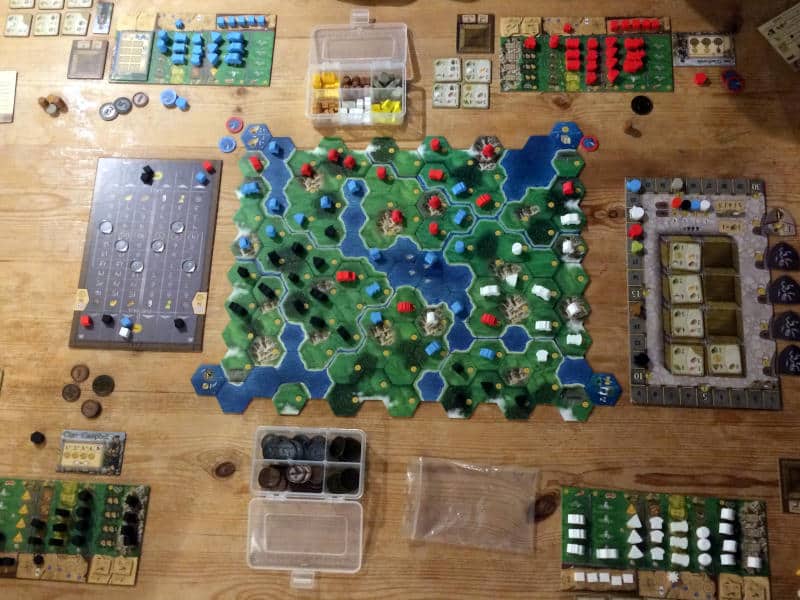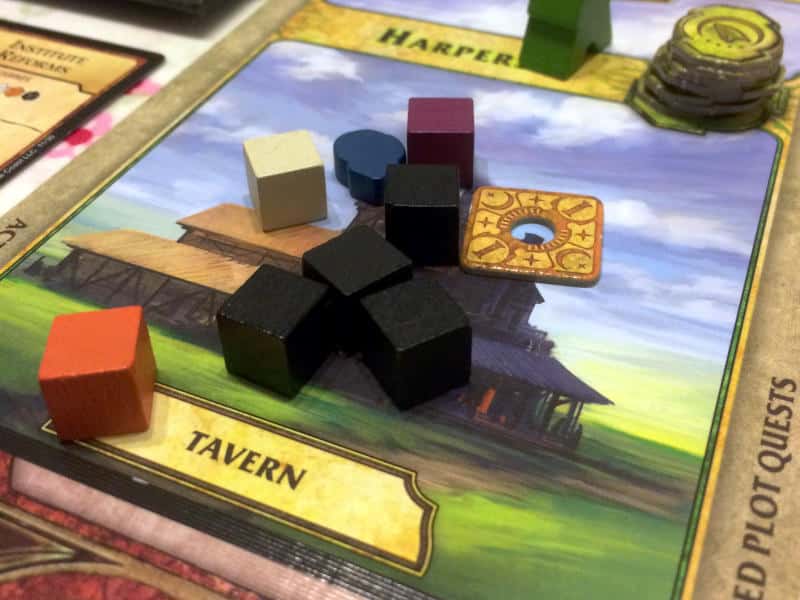As you probably know by now, I’m a very visual person. I love great illustrations in board games, hence my series “Let me illustrate” highlighting board game artists in the industry. At the same time, a board game with an amazing look alone is not enough. The gameplay needs to be great too and the rules must not be more complicated than necessary for the weight of the game. So in this article, I want to look at how important realistic resources are to me in games.
Let’s start at one end of the spectrum and work our way to the other end.
Realistic Resources
I think the most visually appealing are so-called realistic resources. These are usually resin models in a colour fitting for the resource they represent. If they’re painted, then even more amazing. These are clearly very popular because there are many suppliers offering their custom resource sets for pretty much every game in our hobby. Many games now also come in deluxe versions with custom resources.
I mean, the coffee beans and sugar cubes in Seize the Bean are just wonderful to look at and play with. The game even adds a dexterity element, if you choose to play with that option. Instead of just taking a specific number of coffee beans, you can optionally use the supplied spoon to scoop up the beans and if you can ladle them all safely onto your player board, they’re yours. That’s really only something you can do with custom resources like that.
The problem is, of course, that these are basically plastic components. They look great, just like highly detailed miniatures do, but they’re made from a material that’s still going to stick around in thousands of years’ time. It’s a decision you have to make for yourself, but I’ve started to move away from plastic as much as possible.
Money
There is also money. I know that it is often not classified as a resource, but technically speaking it is. I really love when money in a game has a real, physical presence and isn’t just paper or cardboard. Metal coins feel heavy in your hand and they make a satisfying clanking sound as you pay for your action. It becomes a real wrench to part with money when it has this sort of physicality. Poker chips give you a very similar feeling, of course. I’m so pleased I’ve got a good set that I can use for games that have money in them.
Custom Wooden Tokens
When we normally talk about resources in board games, we usually mean things such as wood, coal, iron, gold, apples, wheat or other types of goods that we know from the real world. Mind you, there are also fantasy or science-fiction kinds of resources such as mana or energy. Other than realistic resources, as mentioned above, these are sometimes represented by custom wooden tokens. There will be a grey ingot to represent iron or a brown hexagonal prism to represent wood.
Their shapes will usually be quite stylized, but often they are a really good way of representing resources in games. They don’t have the detail as resin components and are usually quite light, but they still do a great job at helping you immerse yourself in the game. It doesn’t feel like you’re using nameless tokens. The custom shapes are usually easily recognizable and it’s clear what you’ve got or what you’re paying with.

Wooden Cubes
When we get to simple, coloured cubes, we’ve reached a point where I find it a lot harder to feel fully immersed in a game. I mean, the coloured cubes in Lords of Waterdeep are great and all that, but I never know which one is the priest, which one is the soldier or whatever else there is. I know that it doesn’t really matter in the game, but it would be nice to really feel like you’re raising an army to fulfil a quest or hiring a group of wizards to do your bidding.
In games like Terra Mystica, the white wooden cubes representing your workers are fine though. After all, the setting and thematic meanings of the components are all very confusing anyway. So you might as well just stick to abstract components that have a specific function in the game and not worry that they might be representing people.
I suppose the cubes I’ve mentioned so far aren’t actually resources in the traditional sense, even though they are used that way in these games. However, there are plenty of games where you have grey cubes to represent iron, brown cubes for wood and so on. It’s fine to keep these resources quite abstract and just focus on the gameplay. Yet, if you want a game where you can immerse yourself in the world it creates, then I would expect custom wooden tokens. Coloured cubes don’t do it for me.

Cardboard (or Paper)
The last type of component that represents resources in board games is cardboard – or sometimes paper. Cardboard tokens sometimes feel like a step up from coloured cubes, but at the same time, they’re not as much fun to handle. Cardboard tokens can be wonderfully illustrated and cut in different shapes, but more often than not, they’re not as easy to identify across the table. Coloured cubes, even if they’re small ones, are usually easier to see, provided their colours are clearly different. Picking up a bunch of coloured cubes is also a lot more fun than a stack of cardboard tokens.
So, yes, cardboard tokens are a step down from coloured cubes for me when it comes to representing resources. When it comes to money, cardboard or paper is most definitely a big no for me, except maybe really good paper money. Metal coins or poker chips are my preference here 99% of the time.
That doesn’t mean cardboard and paper don’t have a place in games though. Cardboard tokens are ideal for markers or similar. If you want to track which worker placement spots are blocked off until a later round in the game for example, then cardboard tokens are ideal for placing over them. They make it clear that you can’t go there at the moment.
Happy Medium
I think custom wooden tokens are a great compromise between not using highly detailed resin or plastic resources and relying on cardboard chits. If a game has a good selection of wooden tokens that clearly represent the resources they stand in for, then I will be very happy.
Looking at my collection, I reckon most of my games do have custom wooden tokens in them. There are maybe only one or two that have plastic resources and a good few with cardboard counters.
What About You?
How do you feel about different types of resource components? Are you happy with cardboard chits or do you need the deluxe resin token for every game? Do you have any games with custom wooden tokens and how do you feel about them? Please share your thoughts in the comments below. I’d love to hear from you.
Useful Links
- Let me illustrate podcast series: https://tabletopgamesblog.
com/ let-me-illustrate/ - Terra Mystica review: https://tabletopgamesblog.
com/ 2019/ 06/ 01/ terra-mystica/
Audio Version
Intro Music: Bomber (Sting) by Riot (https://www.
Background Music: Sinuswelle by Sascha Ende®
Link: https://filmmusic.
License: https://filmmusic.

